Grid-Connected Photovoltaic Systems with Single-Axis Sun Tracker: Case Study for Central Vietnam
Abstract
1. Introduction
2. Methods and Case Description
2.1. Design of the Sun-Tracking System
2.1.1. Electrical Parameters and Specifications
2.1.2. Design of Mechanical Parameters
2.2. Case Study
3. Result and Discussion
3.1. Evaluation of Energy Consumption by the Sun Tracker
3.2. Performance of the Sun Tracking System on a Sunny Day
3.3. Performance of the Sun Tracking System on a Cloudy Day
3.4. Performance of the Sun Tracking System on a Rainy Day
4. Conclusions
Author Contributions
Funding
Conflicts of Interest
Abbreviations
| Nomenclature | Abbreviation | Unit |
| Peak maximum power | Pmp | Wp |
| Open-circuit voltage | Voc | V |
| Short-circuit current | Isc | A |
| Peak maximum voltage | Vmp | V |
| Peak maximum current | Imp | A |
| Input voltage | Uin | VDC |
| Output voltage | Uout | VAC |
| Total harmonic distortion | THD | % |
| Width of solar panel | a | mm |
| Length of solar panel | b | mm |
| Weight | m | Kg |
| Dimension 1 of rectangular frame | c | mm |
| Dimension 2 of rectangular frame | d | mm |
| Height of rectangular frame | h | mm |
| Distance from the axis of rotation to the anchor locations of the lower-end actuator; | l1 | mm |
| Distance from the axis of rotation to the anchor locations of the upper-end actuator | l2 | mm |
| Distance from the axis of the roller bearings, B’, to the frame of the solar panels | l3 | mm |
| Distance from the axis of roller bearings, A’, to the pillars | l4 | mm |
| Initial rotation angle between the support frame and the vertical axis (pillars) | αmin | ° |
| Maximum angle | αmax | ° |
| Stroke of linear actuator | Dstr | mm |
| Fully retracted length of linear actuator | dmin | mm |
| Completely extended length of linear actuator | dmax | mm |
| Force of linear actuator | F | N |
| Actuator torque | Mact | Nm |
| Angle between the plane of the solar panel and the straight line along the linear actuator | θ | ° |
| Eccentric moment | Me | Nm |
| The eccentricity | e | m |
| Angle between the solar panel and the vertical axis | α | ° |
| Aerodynamic torque | Mwind | Nm |
| Coefficient that depends on the angle between the wind direction and the solar panel | CM | |
| Wind speed | vwind | m/s |
| Surface area of the solar panel | A | m2 |
| Inertia torque | Mqt | Nm |
| Angular acceleration | εmax | rad/s2 |
| Moment of inertia of the rotational part and the solar panels | J | Kg.m2 |
| Daily energy generated by the system with sun tracking | E1 | Wh |
| The energy generated by the system without sun tracking | E2 | Wh |
| The total power consumption of the controller circuit and the linear actuator | E3 | Wh |
| Average improvement | η | % |
| Overall efficiency | η* | % |
References
- Faturay, F.; Vunnava, V.S.G.; Lenzen, M.; Singh, S. Using a new USA multi-region input output (MRIO) model for assessing economic and energy impacts of wind energy expansion in USA. Appl. Energy 2020, 261, 114141. [Google Scholar] [CrossRef]
- Emeksiz, C.; Demirci, B. The determination of offshore wind energy potential of Turkey by using novelty hybrid site selection method. Sustain. Energy Technol. Assess. 2019, 36, 100562. [Google Scholar] [CrossRef]
- Zhao, L.-C.; Zou, H.-X.; Yan, G.; Liu, F.-R.; Tan, T.; Wei, K.-X.; Zhang, W.-M. Magnetic coupling and flextensional amplification mechanisms for high-robustness ambient wind energy harvesting. Energy Convers. Manage. 2019, 201, 112166. [Google Scholar] [CrossRef]
- Zhang, H.; Zhou, B.; Vogel, C.; Willden, R.; Zang, J.; Zhang, L. Hydrodynamic performance of a floating breakwater as an oscillating-buoy type wave energy converter. Appl. Energy 2020, 257, 113996. [Google Scholar] [CrossRef]
- Xu, X.; Robertson, B.; Buckham, B. A techno-economic approach to wave energy resource assessment and development site identification. Appl. Energy 2020, 260, 114317. [Google Scholar] [CrossRef]
- Cuttler, M.V.W.; Hansen, J.E.; Lowe, R.J. Seasonal and interannual variability of the wave climate at a wave energy hotspot off the southwestern coast of Australia. Renew. Energy 2020, 146, 2337–2350. [Google Scholar] [CrossRef]
- Maggio, G.; Nicita, A.; Squadrito, G. How the hydrogen production from RES could change energy and fuel markets: A review of recent literature. Int. J. Hydrogen Energy 2019, 44, 11371–11384. [Google Scholar] [CrossRef]
- Fonseca, J.D.; Camargo, M.; Commenge, J.-M.; Falk, L.; Gil, I.D. Trends in design of distributed energy systems using hydrogen as energy vector: A systematic literature review. Int. J. Hydrogen Energy 2019, 44, 9486–9504. [Google Scholar] [CrossRef]
- Chapman, A.; Itaoka, K.; Hirose, K.; Davidson, F.T.; Nagasawa, K.; Lloyd, A.C.; Webber, M.E.; Kurban, Z.; Managi, S.; Tamaki, T.; et al. A review of four case studies assessing the potential for hydrogen penetration of the future energy system. Int. J. Hydrogen Energy 2019, 44, 6371–6382. [Google Scholar] [CrossRef]
- Zhang, Y.; Ren, J.; Pu, Y.; Wang, P. Solar energy potential assessment: A framework to integrate geographic, technological, and economic indices for a potential analysis. Renew. Energy 2020, 149, 577–586. [Google Scholar] [CrossRef]
- Lobaccaro, G.; Croce, S.; Lindkvist, C.; Munari Probst, M.C.; Scognamiglio, A.; Dahlberg, J.; Lundgren, M.; Wall, M. A cross-country perspective on solar energy in urban planning: Lessons learned from international case studies. Renew. Sust. Energ. Rev. 2019, 108, 209–237. [Google Scholar] [CrossRef]
- Kaya, O.; Klepacka, A.M.; Florkowski, W.J. Achieving renewable energy, climate, and air quality policy goals: Rural residential investment in solar panel. J. Environ. Manage. 2019, 248, 109309. [Google Scholar] [CrossRef] [PubMed]
- Li, G.; Shittu, S.; Diallo, T.M.O.; Yu, M.; Zhao, X.; Ji, J. A review of solar photovoltaic-thermoelectric hybrid system for electricity generation. Energy 2018, 158, 41–58. [Google Scholar] [CrossRef]
- Awasthi, A.; Shukla, A.K.; SR., M.M.; Dondariya, C.; Shukla, K.N.; Porwal, D.; Richhariya, G. Review on sun tracking technology in solar PV system. Energy Rep. 2020, 6, 392–405. [Google Scholar] [CrossRef]
- Ghosh, B.K.; Weoi, C.N.J.; Islam, A.; Ghosh, S.K. Recent progress in Si hetero-junction solar cell: A comprehensive review. Renew. Sust. Energ. Rev. 2018, 82, 1990–2004. [Google Scholar] [CrossRef]
- Parida, B.; Yoon, S.; Jeong, S.M.; Cho, J.S.; Kim, J.-K.; Kang, D.-W. Recent progress on cesium lead/tin halide-based inorganic perovskites for stable and efficient solar cells: A review. Sol. Energy Mater. Sol. Cells 2020, 204, 110212. [Google Scholar] [CrossRef]
- Mohamad, A.A. Physical properties of quasi-solid-state polymer electrolytes for dye-sensitised solar cells: A characterisation review. Sol. Energy 2019, 190, 434–452. [Google Scholar] [CrossRef]
- Li, G.; Xuan, Q.; Akram, M.W.; Golizadeh Akhlaghi, Y.; Liu, H.; Shittu, S. Building integrated solar concentrating systems: A review. Appl. Energy 2020, 260, 114288. [Google Scholar] [CrossRef]
- Wang, J.; Yuan, Y.; Zhu, H.; Cai, T.; Fang, Y.; Chen, O. Three-dimensional macroporous photonic crystal enhanced photon collection for quantum dot-based luminescent solar concentrator. Nano Energy 2019, 67, 104217. [Google Scholar] [CrossRef]
- Delgado-Sanchez, J.-M. Luminescent solar concentrators: Photo-stability analysis and long-term perspectives. Sol. Energy Mater. Sol. Cells 2019, 202, 110134. [Google Scholar] [CrossRef]
- Hafez, A.Z.; Yousef, A.M.; Harag, N.M. Solar tracking systems: Technologies and trackers drive types – A review. Renew. Sust. Energ. Rev. 2018, 91, 754–782. [Google Scholar] [CrossRef]
- Sumathi, V.; Jayapragash, R.; Bakshi, A.; Kumar Akella, P. Solar tracking methods to maximize PV system output – A review of the methods adopted in recent decade. Renew. Sust. Energ. Rev. 2017, 74, 130–138. [Google Scholar] [CrossRef]
- Al-Rousan, N.; Isa, N.A.M.; Desa, M.K.M. Advances in solar photovoltaic tracking systems: A review. Renew. Sust. Energ. Rev. 2018, 82, 2548–2569. [Google Scholar] [CrossRef]
- Abu-Khader, M.M.; Badran, O.O.; Abdallah, S. Evaluating multi-axes sun-tracking system at different modes of operation in Jordan. Renew. Sust. Energ. Rev. 2008, 12, 864–873. [Google Scholar] [CrossRef]
- Nsengiyumva, W.; Chen, S.G.; Hu, L.; Chen, X. Recent advancements and challenges in Solar Tracking Systems (STS): A review. Renew. Sust. Energ. Rev. 2018, 81, 250–279. [Google Scholar] [CrossRef]
- Almarshoud, A.F. Performance of solar resources in Saudi Arabia. Renew. Sust. Energ. Rev. 2016, 66, 694–701. [Google Scholar] [CrossRef]
- Kuo, K.-C.; Liao, M.-S.; Wang, J.-C.; Lee, Y.-C.; Huang, C.-K.; Chou, C.-Y.; Liu, C.-Y.; Hsu, H.-H.; Chen, P.-H.; Jiang, J.-A. Comprehensive assessment of the long-term energy harvest capabilities for PV systems with different tilt angles: Case study in Taiwan. Renew. Sust. Energ. Rev. 2018, 97, 74–89. [Google Scholar] [CrossRef]
- Huld, T.; Cebecauer, T.; Šúri, M.; Dunlop, E.D. Analysis of one-axis tracking strategies for PV systems in Europe. Prog. Photovoltaics 2010, 18, 183–194. [Google Scholar] [CrossRef]
- Eke, R.; Senturk, A. Performance comparison of a double-axis sun tracking versus fixed PV system. Sol. Energy 2012, 86, 2665–2672. [Google Scholar] [CrossRef]
- Maatallah, T.; El Alimi, S.; Nassrallah, S.B. Performance modeling and investigation of fixed, single and dual-axis tracking photovoltaic panel in Monastir city, Tunisia. Renew. Sust. Energ. Rev. 2011, 15, 4053–4066. [Google Scholar] [CrossRef]
- Drury, E.; Lopez, A.; Denholm, P.; Margolis, R. Relative performance of tracking versus fixed tilt photovoltaic systems in the USA. Prog. Photovoltaics 2014, 22, 1302–1315. [Google Scholar] [CrossRef]
- Eldin, S.A.S.; Abd-Elhady, M.S.; Kandil, H.A. Feasibility of solar tracking systems for PV panels in hot and cold regions. Renew. Energy 2016, 85, 228–233. [Google Scholar] [CrossRef]
- Kies, A.; Schyska, B.; Thanh Viet, D.; von Bremen, L.; Heinemann, D.; Schramm, S. Large-Scale Integration of Renewable Power Sources into the Vietnamese Power System. Energy Procedia 2017, 125, 207–213. [Google Scholar] [CrossRef]
- Baulch, B.; Duong Do, T.; Le, T.-H. Constraints to the uptake of solar home systems in Ho Chi Minh City and some proposals for improvement. Renew. Energy 2018, 118, 245–256. [Google Scholar] [CrossRef]
- Al-Mohamad, A. Efficiency improvements of photo-voltaic panels using a Sun-tracking system. Appl. Energy 2004, 79, 345–354. [Google Scholar] [CrossRef]
- Abdallah, S. The effect of using sun tracking systems on the voltage–current characteristics and power generation of flat plate photovoltaics. Energy Convers. Manag. 2004, 45, 1671–1679. [Google Scholar] [CrossRef]
- Benghanem, M. Optimization of tilt angle for solar panel: Case study for Madinah, Saudi Arabia. Appl. Energy 2011, 88, 1427–1433. [Google Scholar] [CrossRef]
- Gorjian, S.; Ghobadian, B.; Tavakkoli Hashjin, T.; Banakar, A. Experimental performance evaluation of a stand-alone point-focus parabolic solar still. Desalination 2014, 352, 1–17. [Google Scholar] [CrossRef]
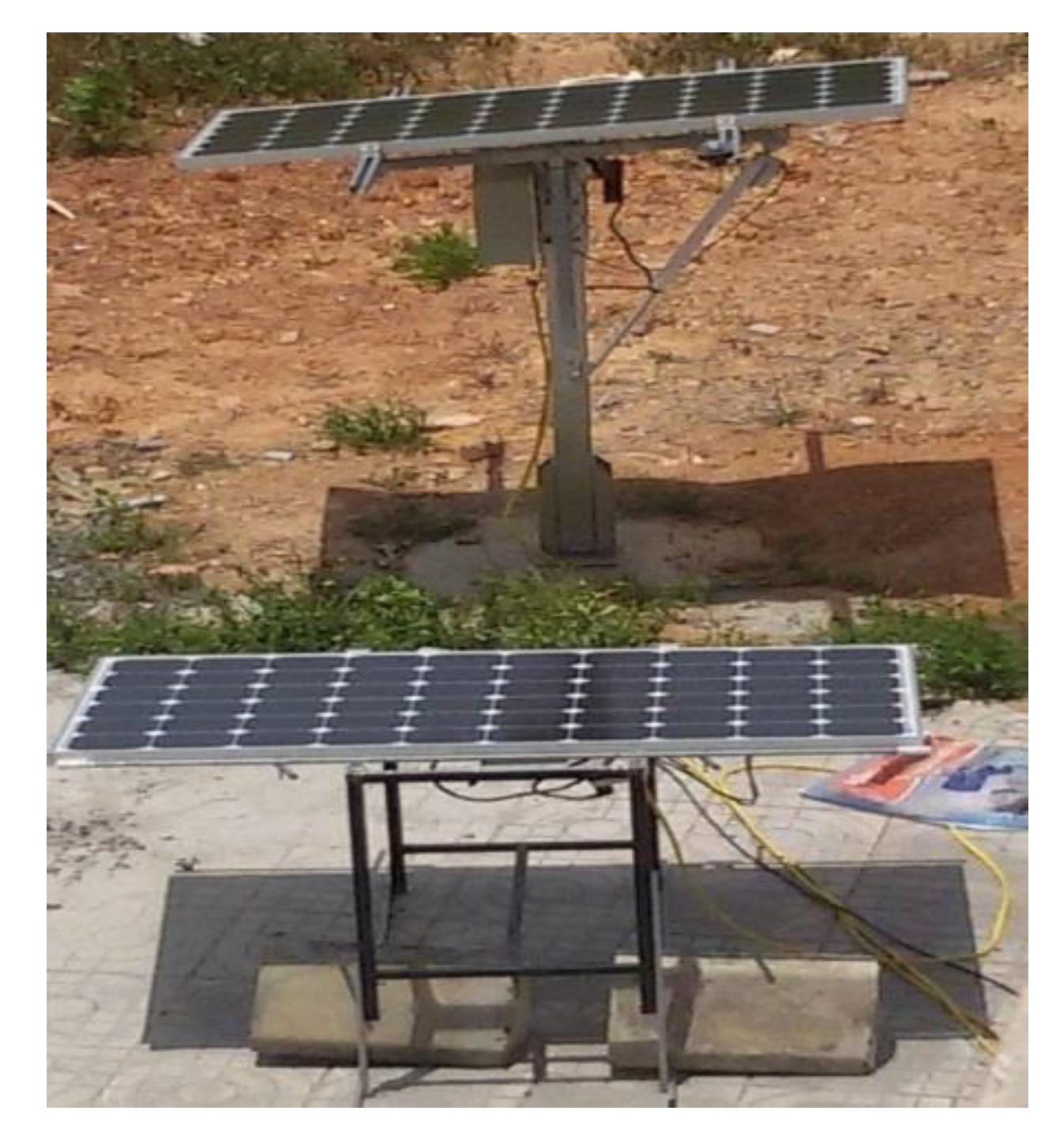
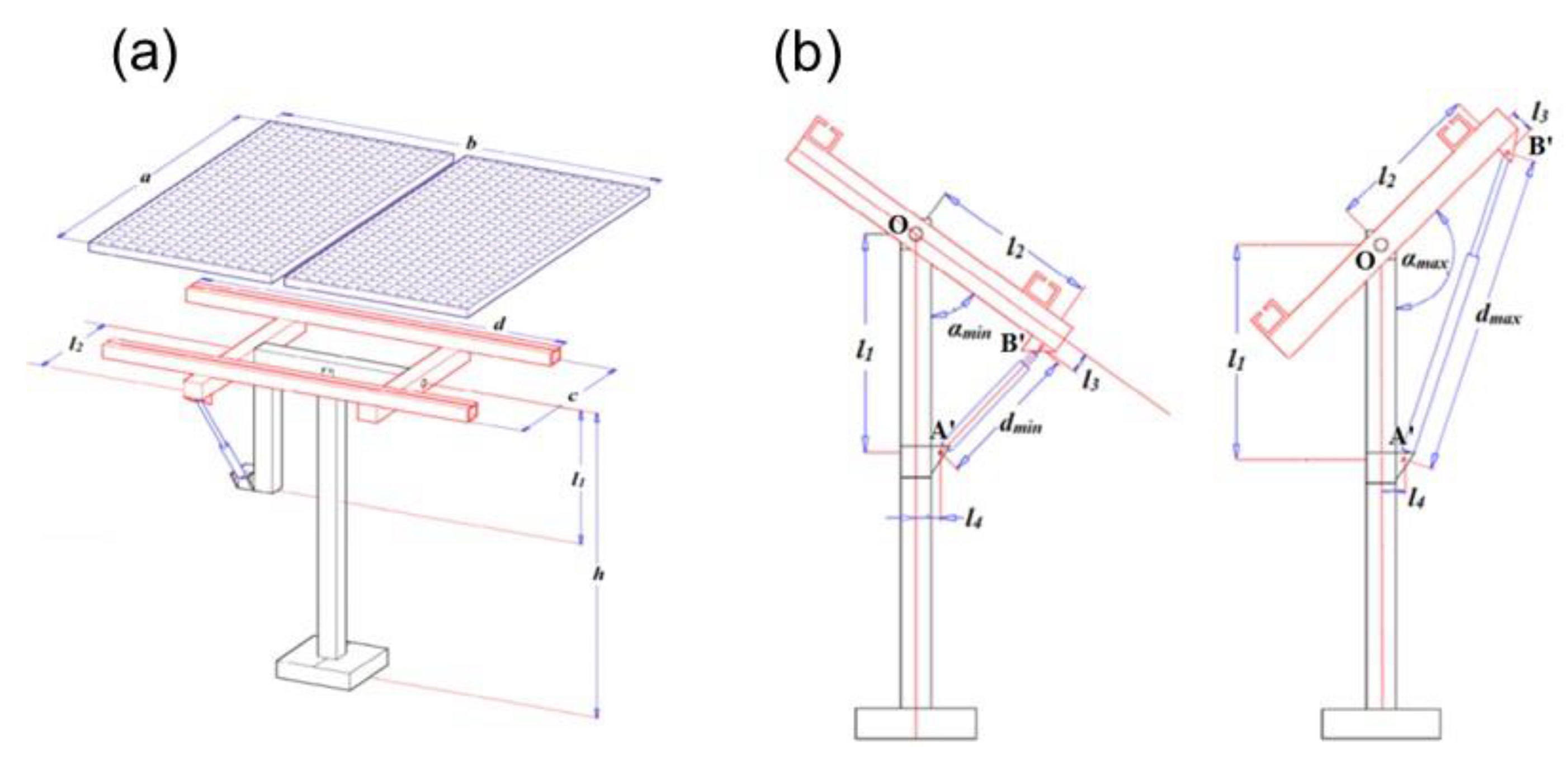
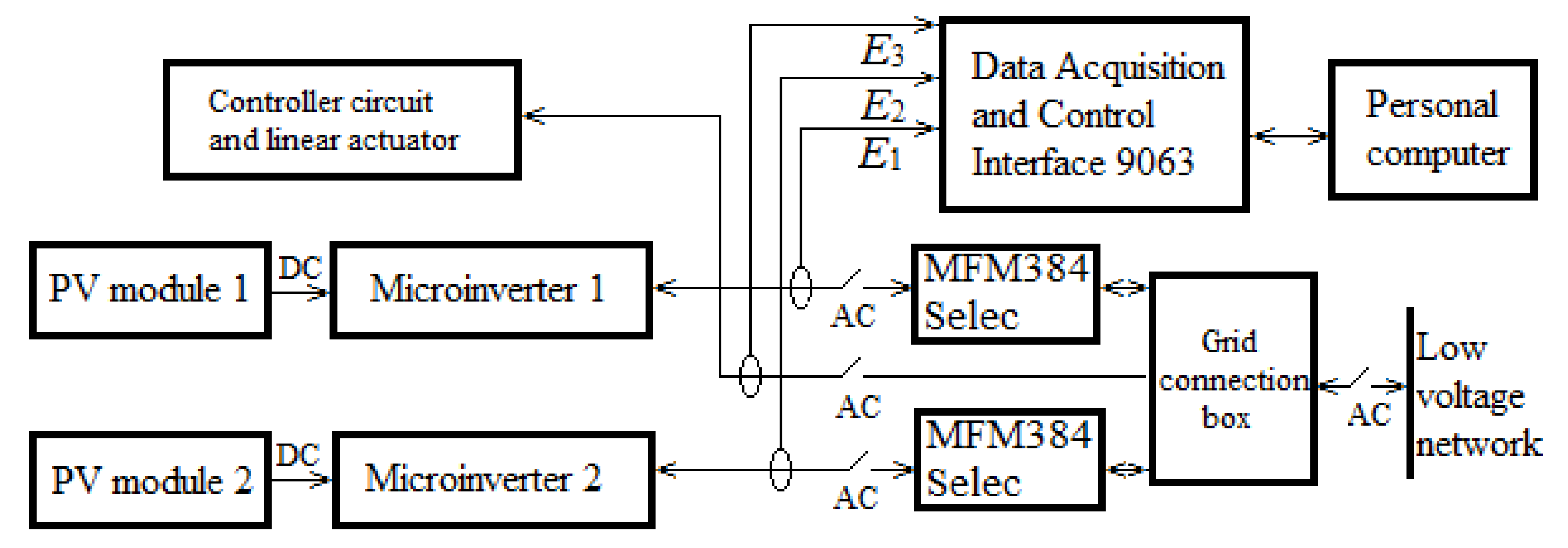
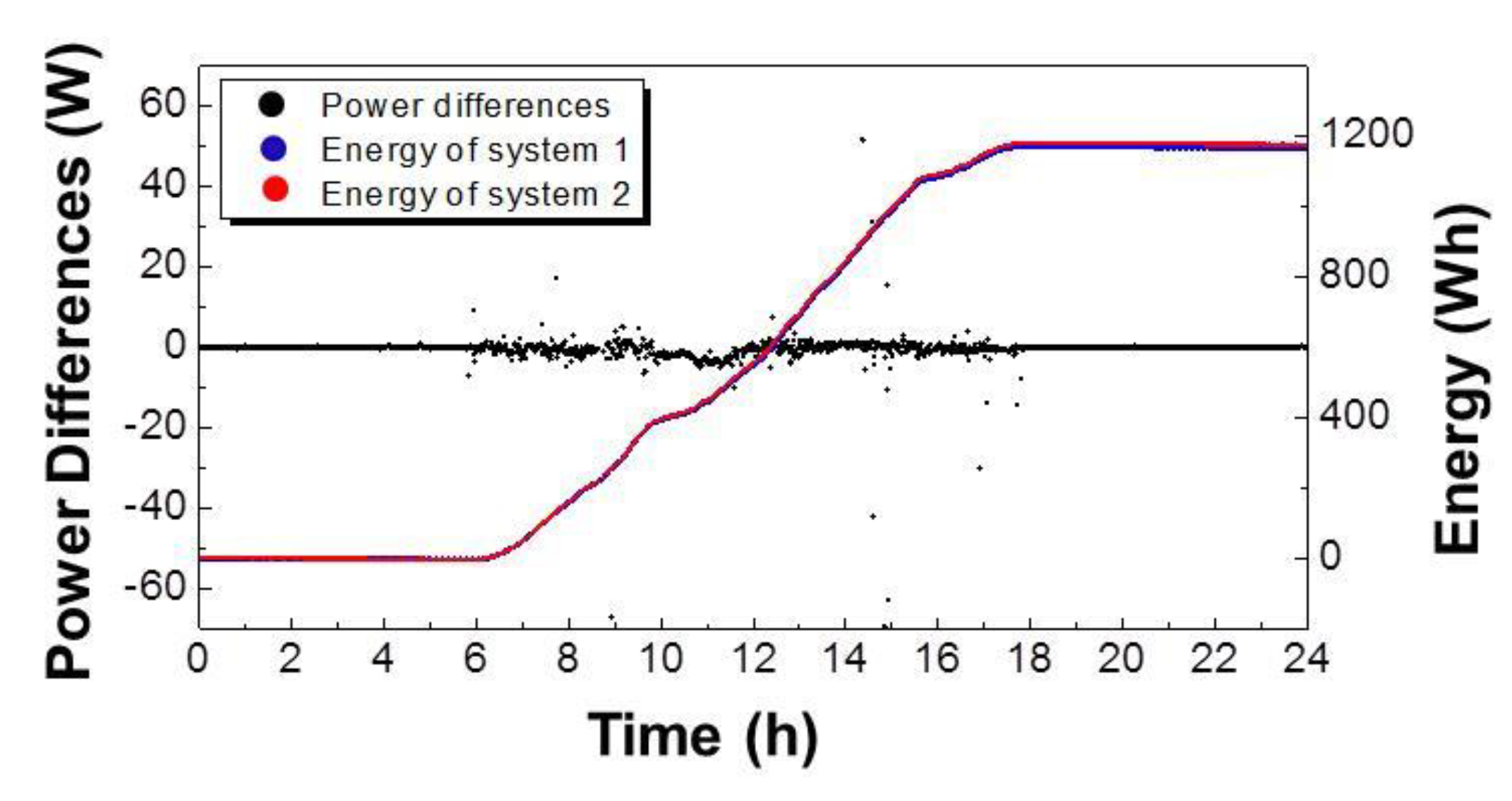
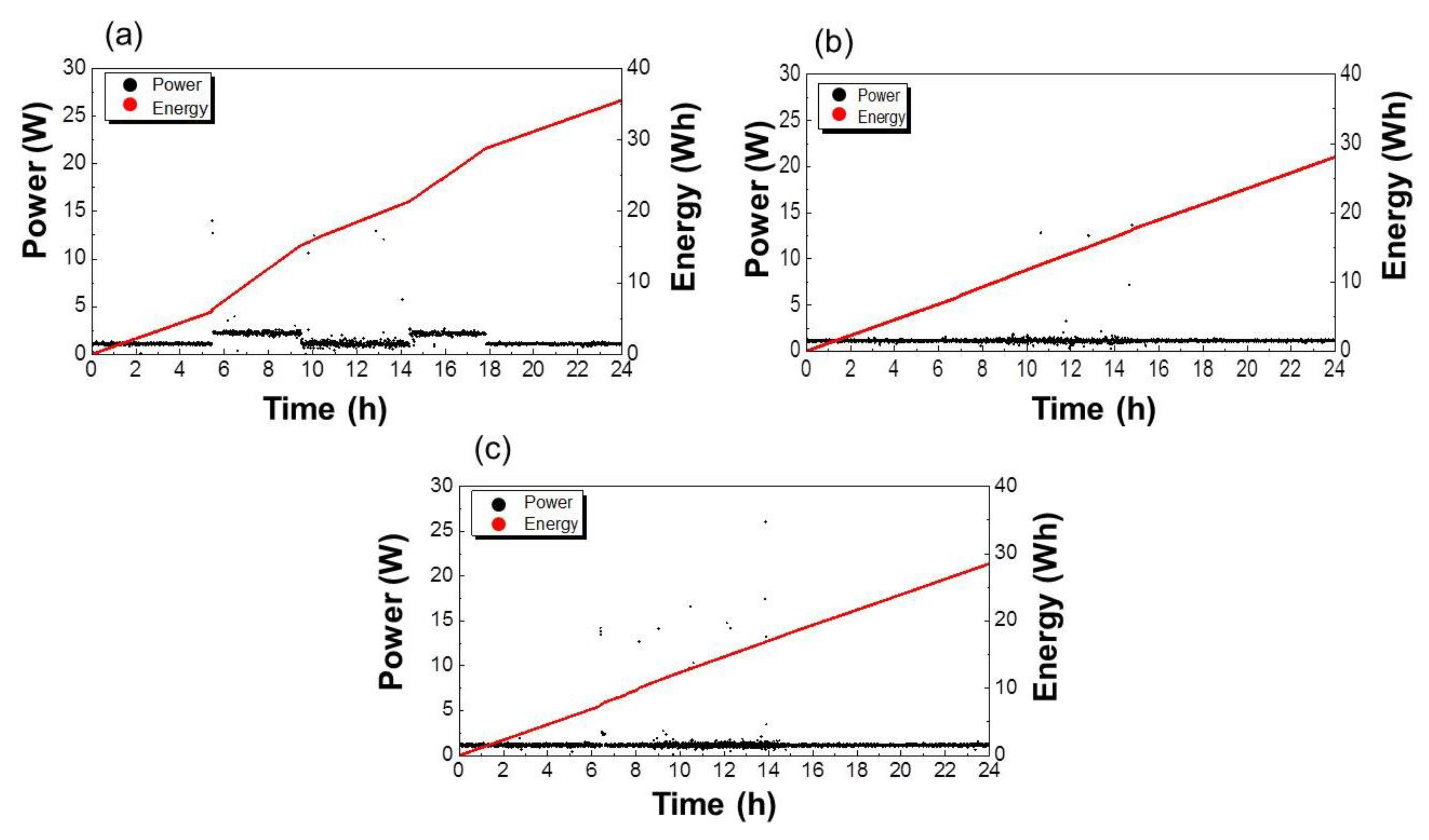
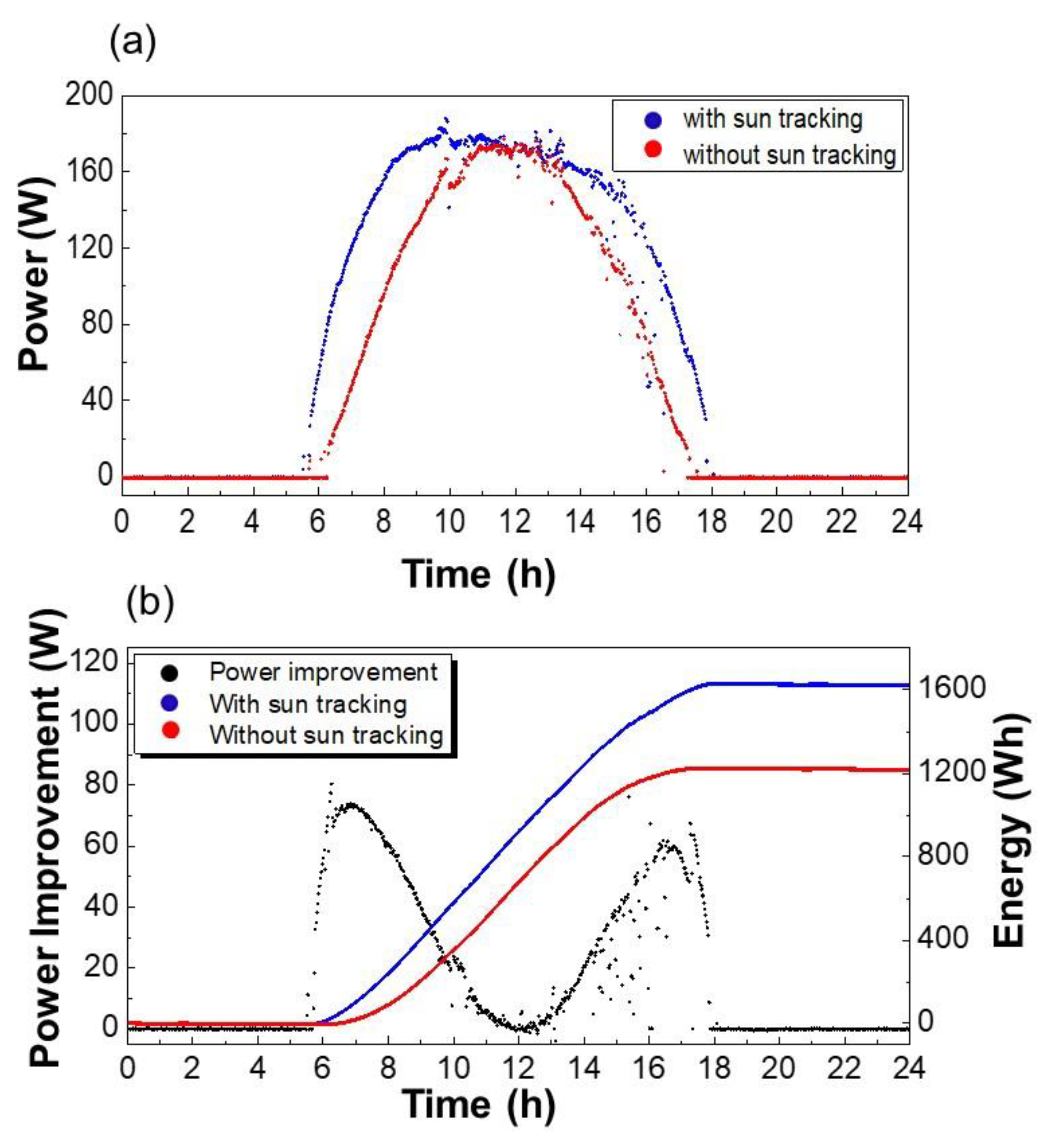
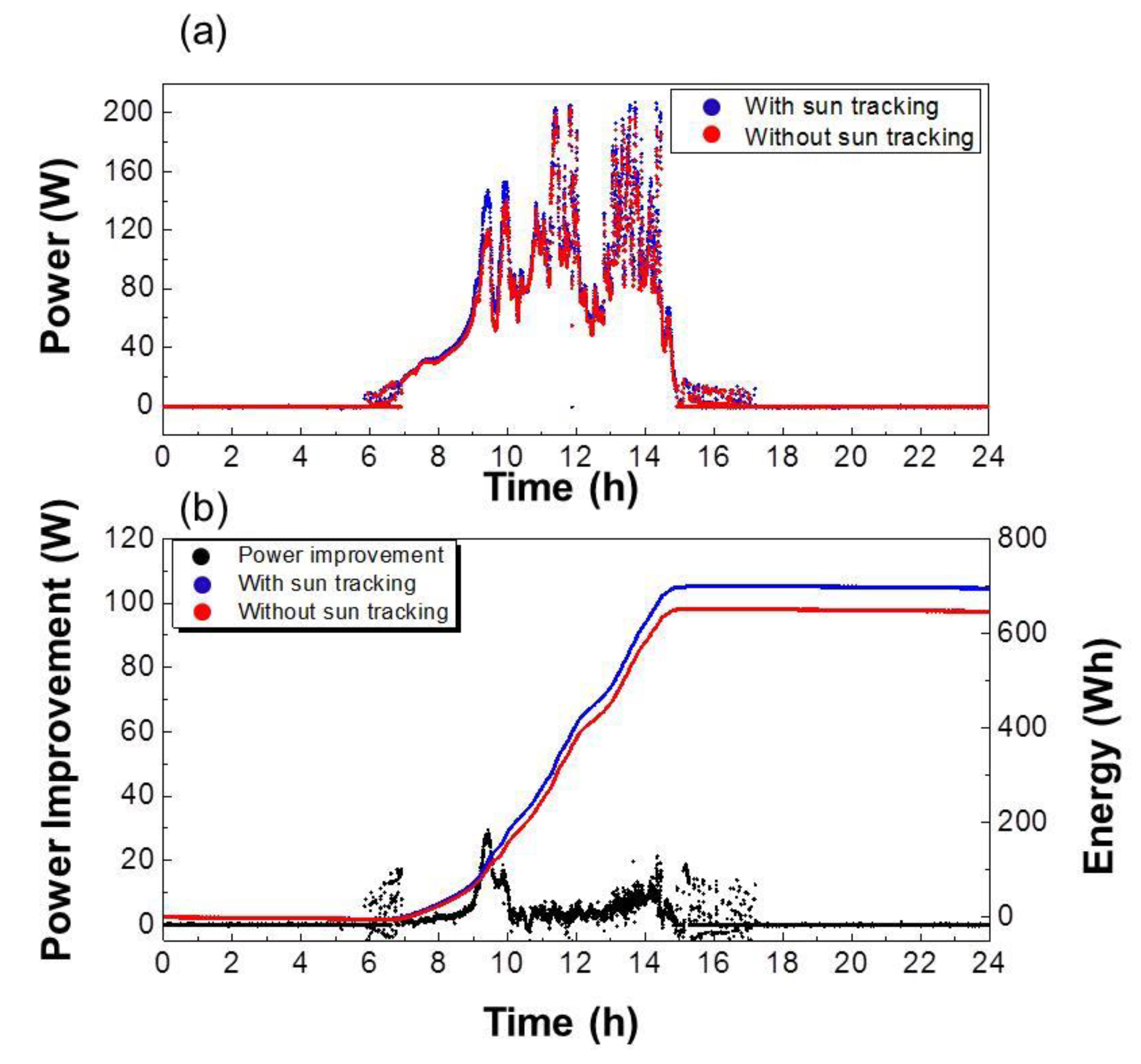
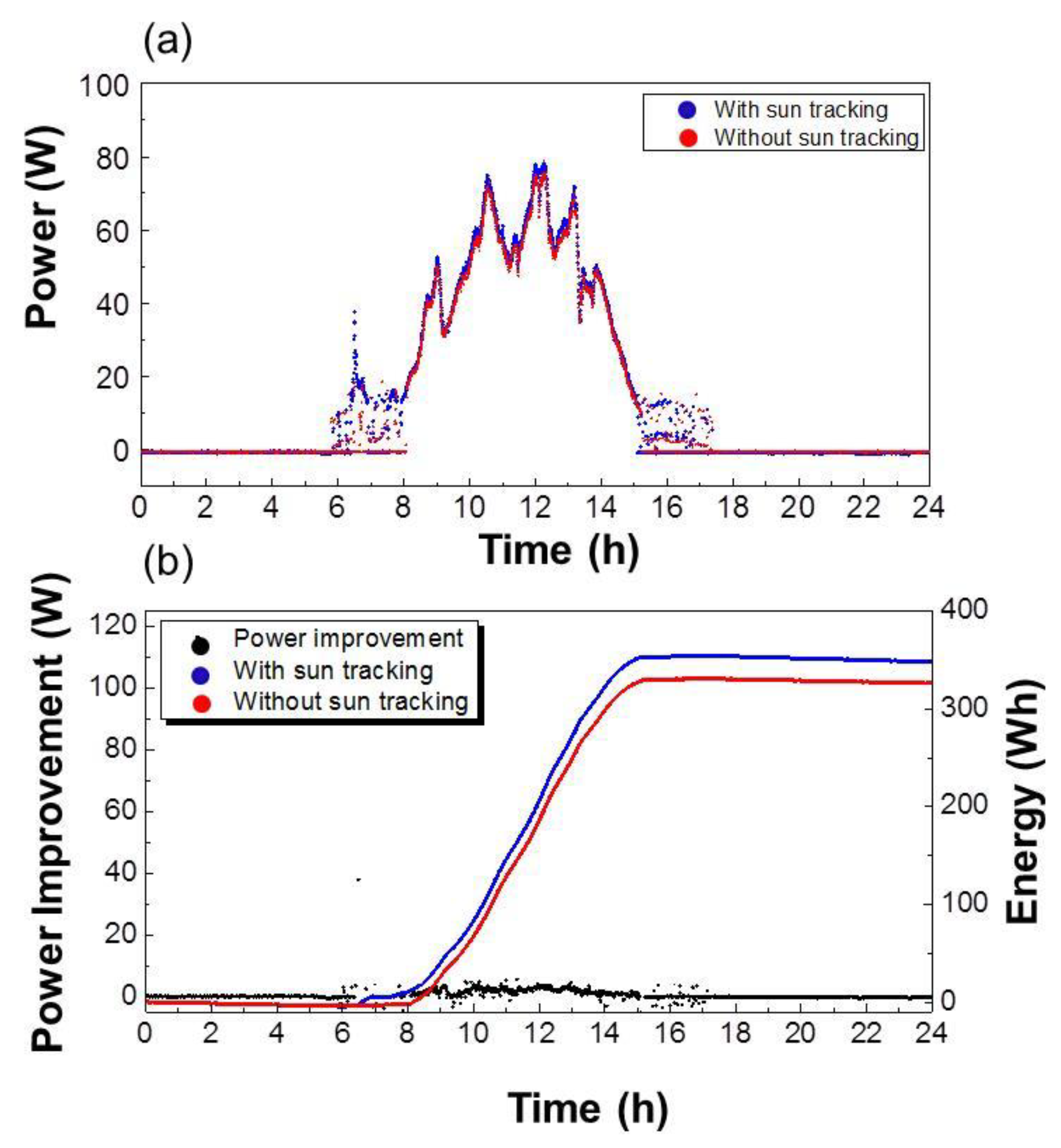
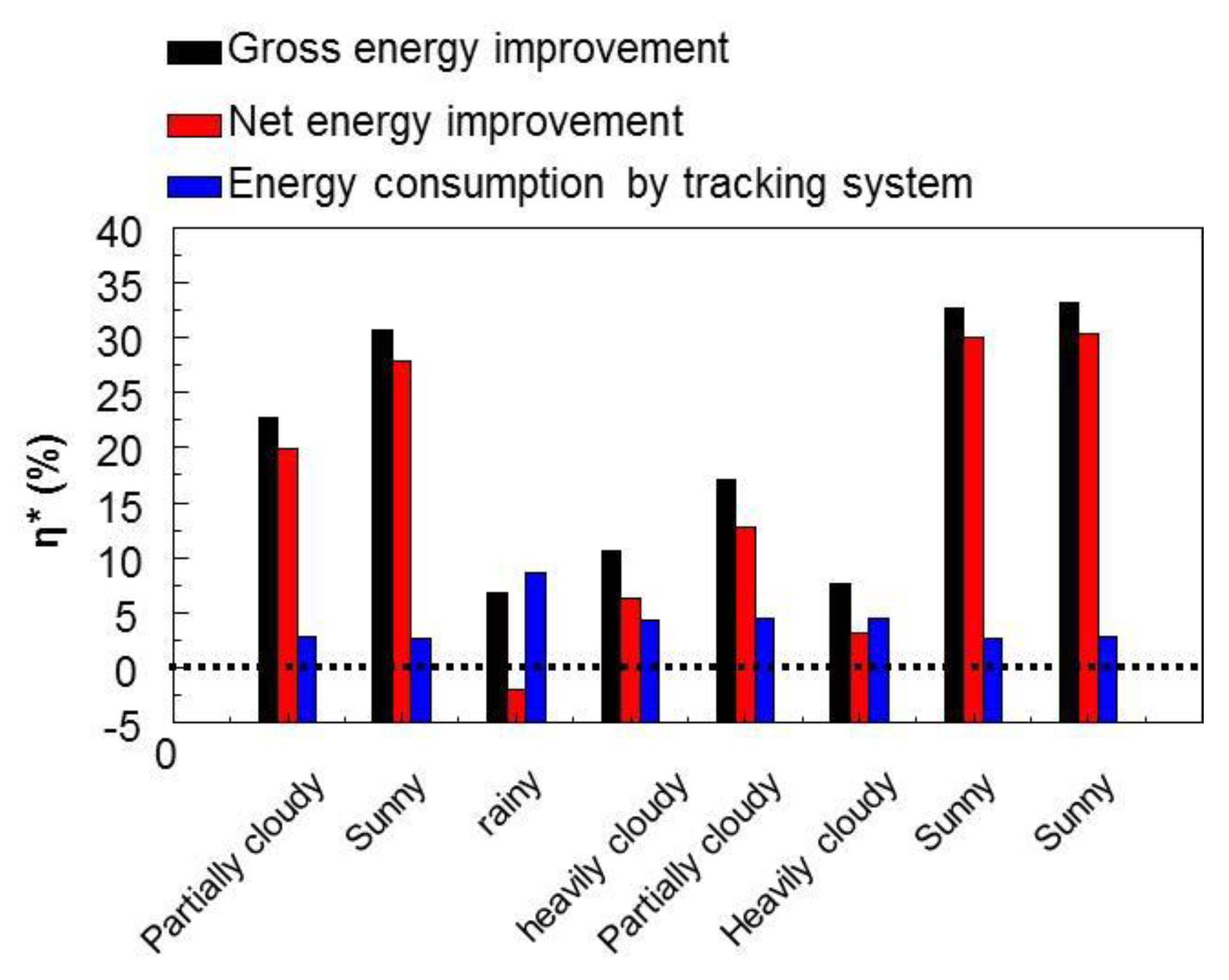
| Properties | Value |
|---|---|
| Peak maximum power Pmp (Wp) | 250 |
| Open-circuit voltage Voc(V) | 37.4 |
| Short-circuit current Isc (A) | 8.83 |
| Peak maximum voltage Vmp (V) | 30.0 |
| Peak maximum current Imp (A) | 8.33 |
| Properties | Value |
|---|---|
| Peak maximum power Pmp (W) | 250 |
| Input voltage Uin (VDC) | 22–45 |
| Output voltage Uout (VAC) | 190–260 |
| Output frequency | 50/60 (auto) |
| Total harmonic distortion TDH | <3% |
| Steady output efficiency | >90% |
| MPPT range (VDC) | 28–36 |
| Power factor | >97% |
| αmin (°) | dmin (mm) | dmax (mm) | Dstr (mm) | Fmax (N) |
|---|---|---|---|---|
| 0 | 375 | 1350 | 975 | 10,000 |
| 15 | 354 | 1323 | 969 | 5701 |
| 30 | 410 | 1275 | 865 | 2847 |
| 45 | 516 | 1206 | 690 | 1623 |
| 60 | 643 | 1120 | 477 | 1332 |
| 75 | 774 | 1017 | 243 | 1159 |
| 90 | 901 | 901 | 0 | 1052 |
© 2020 by the authors. Licensee MDPI, Basel, Switzerland. This article is an open access article distributed under the terms and conditions of the Creative Commons Attribution (CC BY) license (http://creativecommons.org/licenses/by/4.0/).
Share and Cite
Ngo, X.C.; Nguyen, T.H.; Do, N.Y.; Nguyen, D.M.; Vo, D.-V.N.; Lam, S.S.; Heo, D.; Shokouhimehr, M.; Nguyen, V.-H.; Varma, R.S.; et al. Grid-Connected Photovoltaic Systems with Single-Axis Sun Tracker: Case Study for Central Vietnam. Energies 2020, 13, 1457. https://doi.org/10.3390/en13061457
Ngo XC, Nguyen TH, Do NY, Nguyen DM, Vo D-VN, Lam SS, Heo D, Shokouhimehr M, Nguyen V-H, Varma RS, et al. Grid-Connected Photovoltaic Systems with Single-Axis Sun Tracker: Case Study for Central Vietnam. Energies. 2020; 13(6):1457. https://doi.org/10.3390/en13061457
Chicago/Turabian StyleNgo, Xuan Cuong, Thi Hong Nguyen, Nhu Y Do, Duc Minh Nguyen, Dai-Viet N. Vo, Su Shiung Lam, Doyeon Heo, Mohammadreza Shokouhimehr, Van-Huy Nguyen, Rajender S. Varma, and et al. 2020. "Grid-Connected Photovoltaic Systems with Single-Axis Sun Tracker: Case Study for Central Vietnam" Energies 13, no. 6: 1457. https://doi.org/10.3390/en13061457
APA StyleNgo, X. C., Nguyen, T. H., Do, N. Y., Nguyen, D. M., Vo, D.-V. N., Lam, S. S., Heo, D., Shokouhimehr, M., Nguyen, V.-H., Varma, R. S., Kim, S. Y., & Le, Q. V. (2020). Grid-Connected Photovoltaic Systems with Single-Axis Sun Tracker: Case Study for Central Vietnam. Energies, 13(6), 1457. https://doi.org/10.3390/en13061457












